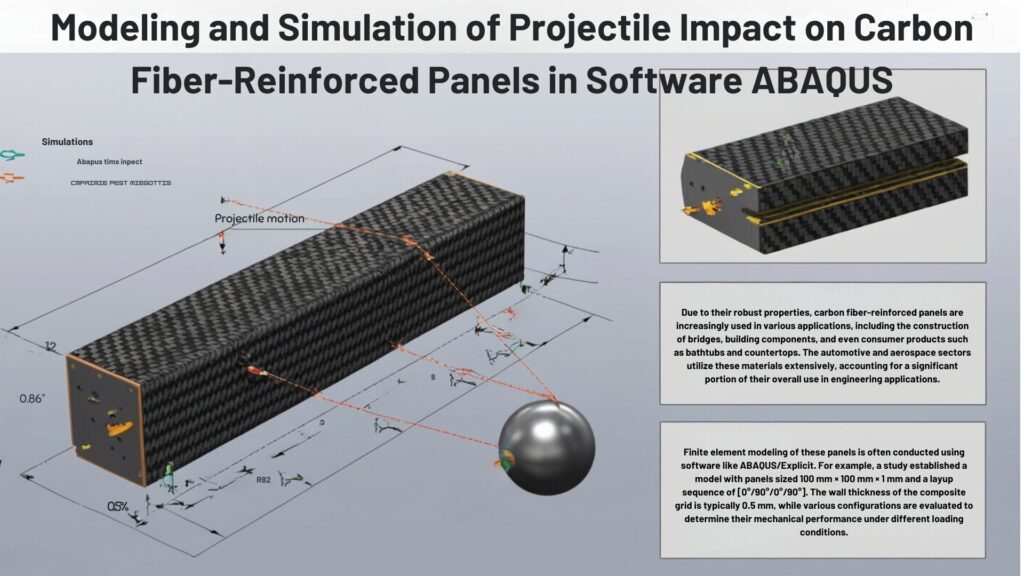
Introduction
Modeling and Simulation of Projectile Impact on Carbon Fiber-Reinforced Panels in Software ABAQUS Modeling and simulation of projectile impact on carbon fiber-reinforced panels using ABAQUS is a critical area of research in the field of material science and engineering. Carbon fiber-reinforced panels, known for their exceptional strength-to-weight ratio, are increasingly employed in aerospace, automotive, and civil engineering applications due to their ability to withstand high-stress conditions.
The accurate simulation of projectile impacts on these materials is essential for understanding their behavior under dynamic loading, which can inform design improvements and enhance safety in real-world applications. The use of ABAQUS, a sophisticated finite element analysis (FEA) software, allows researchers to model complex interactions between projectiles and composite materials. This software supports various material models, enabling the analysis of different failure mechanisms such as fiber rupture and matrix cracking, which are pivotal in assessing the structural integrity of carbon fiber-reinforced panels under impact.
Notably, the accuracy of simulations can be affected by factors such as mesh quality, initial conditions, and the selection of appropriate material models, including the Johnson-Cook model for metallic materials and Hashin’s criteria for composites. Prominent challenges in this domain include ensuring accurate material representation and addressing discrepancies between predicted and actual load capacities. Studies have indicated that while current modeling approaches provide valuable insights, there remains a need for more refined predictive models to capture the unique characteristics of composite materials accurately.
Furthermore, the implementation of progressive damage analysis presents additional complexity in accurately simulating the impact behavior, as it often requires sophisticated user-defined subroutines. As the demand for carbon fiber-reinforced panels grows, the development of advanced simulation techniques and improved material formulations will be crucial for enhancing their performance under high-velocity impacts.
This ongoing research not only has significant implications for the design of protective structures but also contributes to broader applications across various engineering sectors, making it a noteworthy topic in contemporary material science.
Carbon Fiber-Reinforced Panels
Applications
Due to their robust properties, carbon fiber-reinforced panels are increasingly used in various applications, including the construction of bridges, building components, and even consumer products such as bathtubs and countertops. The automotive and aerospace sectors utilize these materials extensively, accounting for a significant portion of their overall use in engineering applications.
Overview
Carbon fiber-reinforced panels are advanced composite materials that utilize carbon fibers as reinforcement in a polymer matrix. These panels are known for their high strength-to-weight ratio, making them suitable for various engineering applications, particularly in fields such as aerospace, automotive, and civil engineering.
Structure and Composition
The carbon fiber-reinforced composite grid sandwich structure is composed of composite panels and grid cores. This structure is characterized by several configurations, including quadrilateral, triangular, mixed, and diamond configurations, enhancing its design flexibility and energy absorption capabilities. The mechanical properties of these panels can be tailored by varying the composite material of the panel and the grid core, thus meeting diverse engineering performance requirements.
Finite Element Modeling
Finite element modeling of these panels is often conducted using software like ABAQUS/Explicit. For example, a study established a model with panels sized 100 mm × 100 mm × 1 mm and a layup sequence of [0°/90°/0°/90°]. The wall thickness of the composite grid is typically 0.5 mm, while various configurations are evaluated to determine their mechanical performance under different loading conditions.
Mechanical Properties
The choice of resin, which acts as the matrix in fiber-reinforced polymer (FRP) composites, is critical as it significantly affects mechanical characteristics. Preferred thermosetting resins like polyesters and epoxies are favored due to their thermal stability and resistance to chemical degradation. Research has shown that increasing the ratio of fiber to resin generally enhances the stiffness and load-bearing capacity of the panels, although an optimal range exists for maximizing structural resilience without compromising integrity.
ABAQUS Software
Overview
ABAQUS is a powerful suite of software tools used for finite element analysis (FEA) and computer-aided engineering (CAE). It enables the modeling and simulation of various physical phenomena, making it particularly useful in engineering fields that require detailed material behavior analysis, such as aerospace, automotive, and civil engineering.
Capabilities
Material Modeling
One of the significant strengths of ABAQUS is its extensive material library, which allows users to simulate both linear and nonlinear material behaviors. This includes isotropic and anisotropic properties essential for analyzing complex composite structures. For instance, ABAQUS can effectively model the damage processes in fiber-reinforced composites, capturing key failure mechanisms such as fiber rupture and matrix cracking.
Simulation Techniques
ABAQUS provides a combination of ABAQUS/Standard and ABAQUS/Explicit to accommodate different simulation needs. The use of dynamic explicit procedures is particularly beneficial for analyzing high-velocity impacts, as it allows for the detailed study of damage evolution under dynamic loading conditions. In low-velocity impact scenarios, the software can preload materials to assess damage progression more accurately.
Mesh Quality
Ensure a fine mesh is applied throughout the model to capture stress and strain gradients accurately. A higher mesh density in critical areas, especially near the impact zones, can lead to more precise results regarding damage and failure.
Contact Definitions
Utilize the general contact algorithm to account for all interactions within the contact domain. Define cohesive interactions between composite layers with specific stiffness parameters and damage criteria to simulate real-world behavior accurately during impact events.
Applications in Impact Simulation
Composite Panel Analysis
ABAQUS is extensively employed for simulating impact scenarios on composite panels, including carbon fiber-reinforced polymer (CFRP) structures. Workshops dedicated to low-velocity impact simulations highlight the software’s ability to capture damage patterns and residual strength outcomes, crucial for design optimization. For example, studies using ABAQUS have shown that impact damage can significantly reduce the compressive strength of CFRP laminates, with findings indicating a residual strength ratio as low as 35% following impact events.
Interaction Modeling
The software’s capability to define contact interactions, such as surface-to-surface contact with penalty behavior, is critical in simulating realistic impact scenarios. Furthermore, careful mesh quality and appropriate initial conditions, like projectile velocities, play a pivotal role in obtaining accurate simulation results.
Documentation and Learning Resources
Getting started with ABAQUS can be challenging, particularly for users unfamiliar with finite element methods. Comprehensive documentation and tutorials are available to assist users in navigating the software and effectively utilizing its features. Additionally, understanding the implications of unit consistency when entering values in ABAQUS is essential for successful simulations.
Modeling Projectile Impact
Modeling projectile impact involves simulating the interaction between projectiles and target materials under high strain rates. Various methodologies and material models are employed to accurately represent the physics of the impact.
Material Modeling
Material behavior under impact is critical for realistic simulations. For instance, the JH-2 model is used to describe damage evolution in materials like silicon carbide, a target material known for its high compressive strength and low tensile capacity. The model incorporates pressure-density relationships and considers the effects of damage, which is significant in high-speed impact scenarios. The projectile in this case is modeled with gold, which contrasts sharply with the target’s properties.
Simulation Process in ABAQUS
Overview of Numerical Simulation Methods
The essence of numerical simulation methods lies in the approximate calculation and characterization of physical phenomena, where the accuracy of results is significantly influenced by the understanding and mathematical characterization of material properties. In simulating projectile impact, defining failure criteria for the material’s deformation limit is crucial for accurate analysis.
ABAQUS Modules for Impact Simulation
The software ABAQUS employs various modules to facilitate the simulation of projectile penetration. For metallic materials, the Johnson-Cook (J-C) model is predominantly utilized, while composite materials often rely on the Hashin and Chang-Chang criteria for damage prediction. For matrix failure predictions, Puck’s criteria provide a more accurate approach. The integration of ABAQUS/Standard and ABAQUS/Explicit allows for preloading the material, simulating its damage process effectively.
Multi-scale Modeling
Modeling in ABAQUS can be conducted across different scales, enabling a comprehensive understanding of material behavior. At the micro-scale (10^-6m), Representative Volume Element (RVE) analysis is a common approach, capturing the material’s intrinsic properties. At the macro-scale (100m), properties are introduced into ABAQUS through laboratory results and existing theories, enhancing the accuracy of the simulations.
Simulation Workflow
The typical workflow for simulating projectile impact in ABAQUS involves several key steps:
- Model Setup: The initial model includes defining the material properties and boundary conditions. For instance, a bottom rigid plate may have fixed conditions, while a projectile is assigned an initial velocity.
- Mesh Generation: A fine mesh is crucial for obtaining accurate results, particularly in the context of stress, strain, damage, and failure analysis during the impact simulation.
- Dynamic Analysis: For repetitive low-velocity impact simulations, a dynamic explicit step is employed alongside mass scaling techniques to reduce simulation time. The ideal contact assumption between interfaces is essential for accurate simulations.
- Results Analysis: Following the simulation, results from stress, strain, and damage assessments become available. Subsequent simulations can utilize initial conditions derived from previous analyses, allowing for the observation of further damage and failure processes.
Practical Applications
ABAQUS has been extensively applied to study the damage mechanisms and failure processes of materials under high and low-velocity impacts. For example, simulations have been conducted on glass fiber aluminum laminates (GLARE) to analyze their response to low-velocity impacts, a common scenario in aircraft structures. Moreover, workshops and tutorials in ABAQUS provide practical insights into composite analysis and material modeling, assisting users in achieving efficient simulations.
Case Studies
Impact Simulation Approaches
Several approaches have been utilized to model the impact behavior of silicon carbide and carbon fiber-reinforced panels under projectile conditions. For instance, three distinct modeling strategies have been applied in the simulation of silicon carbide material. The first case employs the Johnson-Holmquist-B (JHB) material model, while the second utilizes the Johnson-Holmquist-2 (JH-2) model.
The third approach combines multiple options within the Abaqus framework to derive a constitutive model that operates under a more generalized context. This variety in modeling techniques highlights the complexities involved in accurately simulating material responses during high-velocity impacts.
Analysis Considerations
All simulations are conducted using an Abaqus/Explicit dynamic analysis framework, which allows for a detailed examination of the penetration process. Each simulation spans a total duration of 7 microseconds, focusing on the interactions between the high-speed projectile and the target material. The projectile, made of gold, is assigned an initial velocity of 4000 m/s to assess its penetration capabilities against the more rigid silicon carbide target.
Damage Assessment
Damage assessment during the impact is crucial. Stress cloud diagrams illustrate the progression of impact damage through the structure, revealing how damage evolves from the initial contact to complete failure. In specific studies, it has been observed that as the projectile impacts the upper panel of a carbon fiber-reinforced sandwich structure, the load on the panel rapidly escalates, indicating the initiation of damage.
The fiber’s integrity is critical; once broken, the panel’s load-bearing capacity diminishes significantly, leading to overall structural failure. Additionally, the research indicates that the configuration of the grid structure plays a significant role in energy absorption. Specifically, it has been established that as the width of the single lattice increases, the ultimate load capacity of the structure tends to decrease, thus impacting its overall resistance to damage during impacts.
Challenges and Limitations
Modeling Accuracy and Material Representation
One of the significant challenges in modeling projectile impacts on carbon fiber-reinforced panels is ensuring the accuracy of material representation. In simulations, the concrete material modeling is crucial, yet the available material models in the Abaqus library are often inadequate for accurately predicting damage and failure mechanisms.
Consequently, alternative models such as the Johnson-Holmquist material model are employed to address these shortcomings, although they may not fully capture the complexities involved in the behavior of composite materials under impact loading conditions.
Load Capacity Predictions
Another limitation encountered in the analysis is the discrepancy between predicted and actual load capacities. For instance, while the American Concrete Institute (ACI) code provides a baseline for expected load capacities, research indicates that the actual load capacities of strengthened beams often exceed these predictions by an average of 15% when reinforced with fiber-reinforced polymer (FRP) composites.. This inconsistency highlights the need for more refined predictive models that can accommodate the unique properties of composite materials.
Simulation Parameters and Mesh Quality
The quality of the mesh used in the simulations significantly affects the results obtained. A fine mesh is essential for accurate results, yet it also leads to increased computational demands and longer simulation times. Balancing the mesh quality with computational efficiency poses a persistent challenge in the modeling process, particularly for complex simulations involving multiple material interfaces and contact interactions.
Impact Velocity Thresholds
Distinguishing between low-velocity and high-velocity impacts can also complicate analyses. The thresholds for categorizing impacts vary by industry and application, which can lead to ambiguities in defining the parameters of the simulations. Low-velocity impacts, typically characterized by speeds below a certain threshold, require specific modeling approaches that differ from those used for high-velocity impacts.
Progressive Damage Analysis
Lastly, the implementation of progressive damage analysis frameworks in simulations can introduce further complexity. While user material subroutines (UMAT/VUMAT) enable the modeling of progressive damage, debugging these subroutines for large models can be inefficient and cumbersome, given that the subroutine is invoked at each integration point. This necessitates the use of separate standalone programs for testing, which can complicate the workflow for users not familiar with such systems.
Best Practices
When modeling and simulating projectile impact on carbon fiber-reinforced panels using ABAQUS, several best practices should be adhered to in order to ensure accurate and reliable results.
Model Setup
Material Definition
A thorough understanding of the composite materials is crucial. The composite should be defined with appropriate mechanical properties, including elastic and inelastic behaviors, as well as thermal and acoustic properties when necessary. Utilize the extensive material library in ABAQUS to cover both linear and nonlinear properties, ensuring that behaviors are mutually exclusive and compatible with the composite’s architecture.
Multi-Scale Modeling
Employ multi-scale modeling approaches to analyze the composite structure effectively. Begin by modeling at macro (100m), meso (10^-3m), and micro (10^-6m) scales, as this can provide insights into the material’s behavior under different loading conditions and enhance the accuracy of the results.
Dynamic Analysis
Time Step Control
In dynamic explicit simulations, control the time step adequately to capture rapid changes during impact. Implement mass scaling techniques to enhance computational efficiency without sacrificing stability. This approach is particularly useful in low-velocity impact simulations, allowing for quicker convergence and analysis.
Initial Conditions
Set the initial conditions based on prior simulations to evaluate progressive damage. For example, in subsequent simulations, use results from earlier analyses as starting conditions to observe further material behavior under continued loading.
Validation
Comparison with Experimental Data
Validate the numerical model by comparing simulation results with experimental outcomes. This can help ensure the accuracy of the model in predicting critical parameters such as ultimate load and failure modes. Small discrepancies (2-7%) between predicted and actual results are typically acceptable, but ongoing validation against full-scale tests is recommended.
By following these best practices, users can effectively model and simulate projectile impacts on carbon fiber-reinforced panels in ABAQUS, leading to enhanced understanding and performance predictions of composite materials under dynamic loading conditions.
Future Directions
Advancements in Material Selection and Composition
Future research should focus on the selection and formulation of advanced resin types to enhance the performance characteristics of fiber-reinforced polymers (FRPs). Exploring innovative thermosetting resins, such as modified polyesters and novel epoxy formulations, could lead to improved mechanical properties, thermal resistance, and reduced creep behavior in civil engineering applications.. This is crucial as the choice of matrix plays a significant role in the overall performance of FRP composites, affecting factors such as load transmission and environmental durability.
Integration of Simulation Technologies
The integration of sophisticated numerical simulation tools like ABAQUS and ANSYS in the modeling of FRP behavior under various loading conditions represents a significant area for future exploration. By employing advanced finite element analysis (FEA) methods, researchers can simulate complex damage mechanisms, such as delamination and fiber rupture, under high strain scenarios. The development of user-defined material models, such as VUMAT codes for impact and compression analysis, will also be critical in refining the accuracy of simulations related to FRP composites.
Real-World Application and Testing
Conducting more comprehensive experimental studies in real-world conditions will enhance the understanding of the performance of FRP materials in various applications. Investigating the behavior of FRP-reinforced structures under diverse environmental conditions and loading scenarios will contribute to establishing reliable design guidelines and codes. This approach is essential for validating simulation results and ensuring that theoretical predictions align with observed behaviors.
Expanding Application Domains
As the applications of FRP composites continue to expand beyond construction into sectors such as automotive, aerospace, and electronics, interdisciplinary research will be vital. Investigating the interplay of FRP materials with other innovative composites and hybrid structures could lead to groundbreaking advancements in performance and functionality across these industries.
Environmental Considerations and Sustainability
Future studies should also address the sustainability of FRP materials, particularly regarding the lifecycle impact of resin selection and the recyclability of composites. Developing bio-based or recyclable resins could contribute significantly to reducing the environmental footprint of FRP composites while maintaining their high performance. By focusing on these key areas, the future of modeling and simulation in the context of projectile impact on carbon fiber-reinforced panels can be further advanced, promoting safer and more efficient designs in engineering applications.



